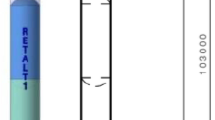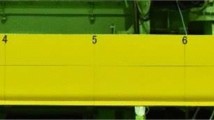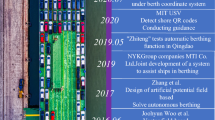Abstract
A floating partial space elevator (PSE) is a PSE with a floating main satellite. This work aims to keep the orbital radius of the main satellite of a floating PSE in cargo transposition without the use of thrusts. A six-degree-of-freedom two-piece dumbbell model was built to analyze the dynamics of a floating PSE. By adjusting the climber’s moving speed and rolling of the end body, the main satellite’s orbital radius can be kept. A novel control strategy using a proportional shrinking horizon model predictive control law containing a self-stability modified law is proposed to stabilize both the orbital and libration states to regulate the speed of only the climber. Simulation results validated the proposed control strategy. The system provides a successful approach to the desired equilibrium by the end of the transposition.

Similar content being viewed by others
References
Aslanov, V. S., Ledkov, A. S. Dynamics of Tethered Satellite Systems. Woodhead Publishing Limited, 2012.
Cosmo, M. L., Lorenzini, E. C. Tethers in Space Handbook. NASA Marshall Space Flight Center, USA, 1997: 224.
Jung, W., Mazzoleni, A. P., Chung, J. Dynamic analysis of a tethered satellite system with a moving mass. Nonlinear Dynamics, 2014, 75(1–2): 267–281.
Shi, G. F., Li, G. Q., Zhu, Z. H. Libration suppression of moon-based partial space elevator in cargo transportation. Acta Astronautica, 2020, 177: 96–102.
Shi, G. F., Zhu, Z. X., Zhu, Z. H. Parallel optimization of trajectory planning and tracking for three-body tethered space system. IEEE/ASME Transactions on Mechatronics, 2019, 24(1): 240–247.
Shi, G. F., Li, G. Q., Zhu, Z. X., Zhu, Z. H. A virtual experiment for partial space elevator using a novel high-fidelity FE model. Nonlinear Dynamics, 2019, 95(4): 2717–2727.
Shi, G. F., Zhu, Z. X., Zhu, Z. H. Libration suppression of tethered space system with a moving climber in circular orbit. Nonlinear Dynamics, 2018, 91(2): 923–937.
Misra, A. K. Attitude dynamics of three-body tethered systems. Acta Astronautica, 1988, 17(10): 1059–1068.
Lorenzini, E. C., Cosmo, M., Vetrella, S., Moccia, A. Dynamics and control of the tether elevator/crawler system. Journal of Guidance, Control, and Dynamics, 1989, 12(3): 404–411.
Cohen, S. S. The effect of climber transit on the space elevator dynamics. Acta Astronautica, 2009, 64(5–6): 538–553.
Woo, P. Dynamics of a partial space elevator with multiple climbers. Acta Astronautica, 2010, 67(7–8): 753–763.
Williams, P. Dynamic multibody modeling for tethered space elevators. Acta Astronautica, 2009, 65(3–4): 399–422.
Ishikawa, Y. Effects of ascending and descending climbers on space elevator cable dynamics. Acta Astronautica, 2018, 145: 165–173.
Kojima, H. Mission-function control of tethered satellite/climber system. Acta Astronautica, 2015, 106: 24–32.
Zhong, R., Zhu, Z. H. Optimal control of nanosatellite fast deorbit using electrodynamic tether. Journal of Guidance, Control, and Dynamics, 2014, 37(4): 1182–1194.
Xu, S. D. A fuzzy control scheme for deployment of space tethered system with tension constraint. Aerospace Science and Technology, 2020, 106: 106143.
Rao, H. P., Zhong, R., Li, P. Fuel-optimal deorbit scheme of space debris using tethered space-tug based on pseudospectral method. Chinese Journal of Aeronautics, 2021, 34(9): 210–223.
Mesmer, F., Szabo, T., Graichen, K. Embedded nonlinear model predictive control of dual-clutch transmissions with multiple groups on a shrinking horizon. IEEE Transactions on Control Systems Technology, 2019, 27(5): 2156–2168.
Sun, Z. Q., Xia, Y. Q., Dai, L., Campoy, P. Tracking of unicycle robots using event-based MPC with adaptive prediction horizon. IEEE/ASME Transactions on Mechatronics, 2020, 25(2): 739–749.
Kang, J. J., Zhu, Z. H., Santaguida, L. F. Analytical and experimental investigation of stabilizing rotating uncooperative target by tethered space tug. IEEE Transactions on Aerospace and Electronic Systems, 2021, 57(4): 2426–2437.
Kang, J. J., Zhu, Z. H. Passivity-based model predictive control for tethered despin of massive space objects by small space tug. IEEE Transactions on Aerospace and Electronic Systems, 2022, doi: https://doi.org/10.1109/TAES.2022.3197097.
Shi, G. F. Stable orbital transfer of partial space elevator by tether deployment and retrieval. Acta Astronautica, 2018, 152: 624–629.
Acknowledgements
This work was funded by the National Natural Science Foundation of China (12102487), Guangdong Basic and Applied Basic Research Foundation (2019A1515111056), and Discovery Grant (RGPIN-2018-05991) of the Natural Sciences and Engineering Research Council of Canada.
Author information
Authors and Affiliations
Corresponding author
Ethics declarations
The authors have no competing interests to declare that are relevant to the contents of this article.
Additional information
Gefei Shi received his B.S., M.S., and Ph.D. degrees from Northwestern Polytechnical University, Xi’an, China, in 2007, 2011, and 2019, respectively. He is currently an associate professor with the School of Aeronautics and Astronautics, Sun Yat-sen University. His research interests include dynamics and control of tethered space systems, partial space elevators, and underactuated control.
Zheng H. Zhu (M’09–SM’12) received his B.Eng. degree in engineering mechanics, M.Eng. degree in solid mechanics, and Ph.D. degree in computational mechanics from Shanghai Jiao Tong University, China, and M.A.Sc. degree in robotics and Ph.D. degree in mechanical engineering from the University of Waterloo and the University of Toronto in Canada, respectively. He is currently a professor and Tier I York Research Chair in Space Technology at the Department of Mechanical Engineering, York University, Toronto, Canada. He has authored more than 187 peer-reviewed journal articles. His current research interests include dynamics and control of tethered space systems and visual servo space robotics for active space debris removal. Dr. Zhu is a College Member of Royal Society of Canada, Fellows of Canadian Academy of Canada, Engineering Institute of Canada, CSME and ASME, the Associate Fellow of American Institute of Aeronautics and Astronautics, the Academician of International Academy of Astronautics, Senior Member of IEEE, and licensed Professional Engineer.
Rights and permissions
About this article
Cite this article
Shi, G., Zhu, Z.H. Orbital radius keeping of floating partial space elevator in cargo transposition. Astrodyn 7, 259–269 (2023). https://doi.org/10.1007/s42064-022-0156-y
Received:
Accepted:
Published:
Issue Date:
DOI: https://doi.org/10.1007/s42064-022-0156-y




